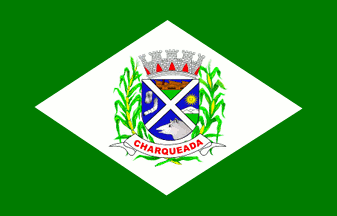 image by Dirk Schönberger,
17 October 2012
image by Dirk Schönberger,
17 October 2012Source: http://189.109.40.26:9005/site/simbolos.php

Last modified: 2012-11-10 by ian macdonald
Keywords: sao paulo | charqueada |
Links: FOTW homepage |
search |
disclaimer and copyright |
write us |
mirrors
 image by Dirk Schönberger,
17 October 2012
image by Dirk Schönberger,
17 October 2012
Source:
http://189.109.40.26:9005/site/simbolos.php
A green flag with the municipal arms on a white lozenge in the centre.
Official website at
http://www.charqueada.sp.gov.br
Dirk Schönberger,
17 October 2012
Charqueada as originally known as Uacuri. The place was subsequently renamed Charqueada, for "charque", a local jerky (dried and salted meat) produced locally thanks to the profuse game. Luís Antonio de Souza Barros, owner of the São Lourenço colony since 1859, built in Charqueada a house near the railway station inaugurated in 1886. The neighbouring ranch once used by cowboys, transformed to house the railways workers, was acquired by Antonio Furlan; considered as the genuine founder of Charqueada. In 1894, he built a pottery workshop, and, in the next years, an hotel, a pharmacy, a forge, a masonry workshop and a sawmill. He also introduced coffee and rice cultivation and purchased the first plows ever used in the region. A school and a chapel were erected in 1901 and 1903, respectively; funded by Furlan, too. The district of Charqueada was established, as part of the municipality of Piracicaba, on 18 August 1911 by Law No. 1,251. The municipality of Charqueada, with the town of Igual as its seat, was established on 30 December 1953 by Law No. 2,456 and inaugurated on 1 January 1955.
The flag is green with a white lozenge charged with the municipal coat of arms. The flag was possibly inspired by the Brazilian national flag, using the same dominant colour (green), the same pattern and the blue colour in the field of the coat of arms. The coat of arms represents, on the flag, the municipal government The white lozenge represents the town as the seat of the municipality. White is a symbol of peace, friendship, work, prosperity, purity and religious feelings. The green field represents the rural estates in the municipality. Green is a symbol of honour, civility, courtesy, joy and abundance; it symbolizes also hope, as the fields greening in spring promise profuse harvest.
The coat of arms is "A classical Flemish Iberic shield surmounted by an eight-towered mural crown ports gules On a field azure, a saltire argent surrounded in chief by a factory or issuant form a terrace vert, dexter by a cocoon and a silkworm argent, sinister by a mountain argent nascent from a terrace vert and ensigned by a heraldic sun or, and in base by the head of a tapir argent issuant from sinister. The shield surrounded dexter by a sugar cane and sinister by a plant of maize the two proper, crossed per saltire below the shield and holding a scroll argent inscribed with the toponym 'CHARQUEADA' in letters gules."
The shield is of the first style introduced from Portugal, inherited
by the Brazilian heraldry to evoke the early colonists and main
builders of the country.
The eight-towered mural crown is the symbol of a second-rank
municipality. The ports gules recall the courage and dedication of the
pioneers and of the leaders of the community.
Gules (red) is a symbol of dedication, patriotic feeling, audacity,
intrepidity, courage and valiance.
Azure (blue) is a symbol of justice, nobleness, perseverance, zeal,
loyalty, recreation and beauty.
The saltire, the seventh of the first-order divisions of the shield,
is a symbol of chivalry. Argent is a symbol of peace, friendship,
work, prosperity, purity and religious feeling.
The factory represents textile industry, especially here silk
production. Or is a symbol of glory, splendor, greatness, wealth and
sovereignty.
The cocoon and silkworm represent the early silk industry.
The mountain represents the Serra de São Pedro, the geographic element
characteristic of the region. The sun symbolizes the mild and healthy
climate of the municipality. Vert (green) has the same meaning as on
the flag (see above).
The tapir represents the abundance of game and "charque", at the
origin of the name of the town.
Sugarcane and maize are the main crops growing on the fertile soil and
the main sources of income.
Ivan Sache, 3 November 2012